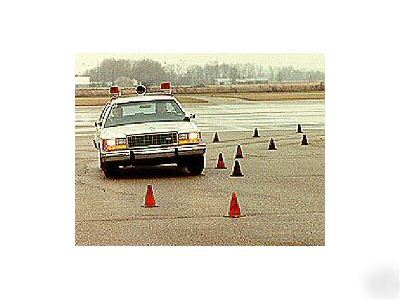Law Enforcement Driver Training Guide 2000
– 760 pages of self-study material with diagrams and illustrations.
This CD is created and produced by planet-e-tech from non-copyrighted, public domain, declassified or non-classified US Government documents, and is designed to work under Windows operating system (the .pdf files are also viewable under other platforms, but some automatic features are likely to be disabled).
All the manuals on this CD are in Adobe Acrobat (.pdf) format, and the latest version of Adobe Acrobat Reader is also included on this CD for your convenience.
Your satisfaction is our priority!
Law Enforcement Driver Training Guide 2000 (760 pages)
The knowledge, skills, and attitudes that the average student brings to a basic recruit training academy are not sufficient for operating a law enforcement vehicle. The type of vehicle driven by civilians and law enforcement officers is similar, but the actual driving task is different. This becomes very obvious when comparing the collision rate for the general population with that of law enforcement officers, which is no less than twice as great.
The information in this Guide is presented in the form of concepts along with guidelines and suggestions for implementation. This information is intended to be a model for a driver training process, not a series of standards or mandates, but a guide. Individual agencies are responsible for reviewing their specific needs and evaluating their current driver training process in light of the information and guidelines offered in this task force report.
q Goals and Philosophy Statement
q Chapter 1 – Establishing a Driver Training Process
q Chapter 2 – Emergency Vehicle Driving Curriculum Guidelines
o Module 1 – Legal Aspects of Law Enforcement Driving
§ Objective 1-2 – Identify statutory law, case law, agency policy, and principles of liability governing non-emergency driving
§ Objective 3-4 – Identify constitutional law, statutory law, and case law government the use of a vehicle as deadly force in terminating pursuits
o Module 2 – Non-Emergency Driving
§ Objective 1 – Identify the reasons for law enforcement driver training
§ Objective 2 – Identify unique characteristics of law enforcement driving
§ Objective 3 – Identify the effects that attitudes and emotions have upon law enforcement driving
§ Objective 4 – Identify common psychological factors that contribute to law enforcement collisions
§ Objective 5 – Identify common physiological factors that contribute to law enforcement collisions
§ Objective 6 – Identify the components of driving that lay the foundation for the development of good driving habits
§ Objective 7 – Identify vehicle defects that contribute to law enforcement collisions
§ Objective 8 – Identify elements of an acceptable law enforcement vehicle inspection
§ Objective 9 – Identify the importance of safety belts and other occupant protection devices
§ Objective 10 – Demonstrate acceptable use of safety belts and other occupant protection devices
§ Objective 11 – Identify common environmental factors that contribute to law enforcement collisions
§ Objective 13 – Identify factors that influence the stopping distance of a vehicle
§ Objective 14 – Identify driving movements that frequently contribute to law enforcement collisions
§ Objective 15 – Identify acceptable vehicle control methods
§ Objective 16 – Identify methods for skid avoidance
§ Objective 17 – Identify acceptable methods for use of the communications radio
§ Objective 18 – Identify factors involved in skid control
o Module 3 – Emergency Response Driving
§ Objective 1 – Identify the types and limitations of emergency warning devices on law enforcement vehicles
§ Objective 2 – Identify factors that contribute to the effective use of a police radio during an emergency response
§ Objective 3 – Identify factors in route selection for an emergency response
§ Objective 4 – Identify the changes in vehicle dynamics that occur during an emergency response
§ Objective 5 – Identify acceptable steering methods for use during an emergency response
§ Objective 6 – Identify acceptable methods of cornering during an emergency response
§ Objective 7 – Identify acceptable backing methods during an emergency response
§ Objective 8 – Identify acceptable collision avoidance methods for use during an emergency response
§ Objective 9 – Identify types of power assist steering loss and acceptable methods of minimizing potential loss of vehicle control
§ Objective 1 – Identify factors that impact on initiating a vehicle pursuit
§ Objective 2 – Identify factors involved when conducting a vehicle pursuit
§ Objective 3 – Identify factors that would warrant the pursuing officer, or supervisor, making the decision to terminate a vehicular pursuit
§ Objective 4 – Identify factors that impact on the termination of a pursuit: suspect voluntary or involuntary stopping
§ Objective 5 – Identify factors to be considered when a law enforcement vehicle is involved in the termination of a vehicular pursuit using various physical intervention techniques (roadblocks)
§ Objective 6 – Identify considerations involved in post-pursuit reporting
§ Objective 7 – Demonstrate the ability to conduct a pursuit
§ Objective 8 – Identify post-litigation preparation considerations
q Chapter 3 – Emergency Vehicle Driving and Policy
q Chapter 4 – Validating a Driver Training Course
q Chapter 5 – Instructor Qualifications
q Chapter 6 – Course Facilities
q Chapter 7 – Management of Emergency Vehicle Operational Risks
q Chapter 8 – Practical Exercises
APPROVED BY U.S. GOVERNMENT FOR PUBLIC DOMAIN RELEASE… DISTRIBUTION UNLIMITED…
Please click here to see other items that we offer for sale!
